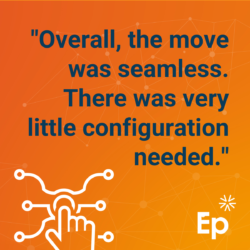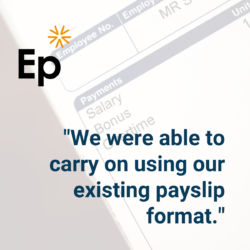Transport for London discusses the move to digital payslips
We joined up with the Chartered Institute of Payroll Professionals for a roundtable conversation with our Group Managing Director, Glyn King, and client, Colin Turner, Employee Payments Delivery lead from Transport for London.
In the conversation, they discussed how Transport for London implemented a move to digital payslips.
The CIPP hosted the interview, chatting through how Transport for London used Epay to transform its payslips process and how they found the process of integrating the digital payslips portal.
Transport for London has 26,000 employees and runs an in-house payroll function. There are eight payroll groups, running weekly, monthly and 4-weekly. Therefore, it is a very busy function, with many people on different pay frequencies. Consequently, the payroll team receives a high number of queries.
The move to digital payslips
The payroll team at Transport for London were previously printing and posting payslips to employees via their internal mail system or through Royal Mail. Unsurprisingly, this was time-consuming and inefficient.
Just before the pandemic, they implemented the secure payslips portal Epay to deliver digital payslips.
Transport for London continued to use its existing SAP technology for payroll processing, using Epay to deliver payslips electronically.
Previously, the system required all users to have an email address and SAP access via a licence to see their payroll information. Not all staff had an email address, and most had no SAP login.
This meant the organisation would either have to:
- Encourage employees to create email addresses (and be comfortable using them)
- Or pay for licences for all employees
Implementing Epay
As a solution to overcome the obstacles, Transport for London chose to bolt the Epay technology onto SAP. The Epay portal takes the SAP data and presents it as digital payslips and P60s on any device.
Colin commented, “Overall, the move was seamless. There was very little configuration needed.

“We used our existing payslip format, which sat well with employees because they saw the same thing they previously received on paper. Now they were just viewing it on screen, but it’s in the same format, so they were happy with that.”
Naturally, with the introduction of any new system, not all employees will be positive about a different way of doing things.
Some employees fear automation technology because of perceived job losses and other organisational changes. Therefore, adoption may take some time.
We encourage clients to follow best practices to educate their employees before launch to aid this transition.
Spend time explaining the change
Transport for London produced guides and videos, roadshows and demonstrations showing how easy it was to log in and how secure it was.
“Colin explained, “The best way to get buy-in was to communicate with colleagues. Visit them face-to-face. Make sure they know you’re approachable.”
Simplify the login with existing platforms
One of the things that Transport for London did was implement a Single Sign-On (SSO) through an employee benefits portal. This helped people find their payslips and drive traffic to the benefits website.
Keeping the payslip format the same
Glyn reiterates that keeping the format the same is key to the success of digital payslips.
“We predominantly replicate exactly the payslip that is produced and that they are used to seeing on paper. Often employees will have three old payslips in a cabinet somewhere that they can look at. If they look at it on their phone, laptop or iPad, and it looks exactly the same as their paper payslip, they relax.
“Epay can display payslips in whatever format, but the employee won’t be happy. For the employee who has to turn up for work at 6 am, all they will want to see is that they have the overtime or shift allowance in the same place as last time.
“As long as they have access to the same payslip, the same look and feel, and they can get to it 24/7, they’re comfortable.”
Other benefits of moving to digital payslips
Colin states the previous process was more expensive, labour-intensive and ineffective.
“It was very resource-heavy. It would take two people 4 or 5 days a period just to produce, distribute [printed payslips], and keep lists up to date. There was so much manual work involved with that. The queries for missing payslips have all disappeared because they are now available online.”

Saving time, costs, consumables, and postage are not the only benefits of using digital pay documents.
There are many benefits of electronic payslips. As well as sharing this information, teams can use the platform for other employee communications.
Transport for London has the control to customise the Epay portal to provide personalised employee communications. Admin users can edit the welcome message and define the content by job title, role, or code. Therefore, the recipient can see a different message if there is a code in the payslip to identify their record.
Colin highlighted, “We also share P60s. When the employee leaves, their P45 is uploaded onto Epay. There are FAQs, and we can put any documents the company wants us to display on there.”
In addition to saved time and costs, and employee communications, Transport for London can use Epay to add value to the business through:
- Running different reports with information that is only available in the portal
- Improving security by eliminating payslips left on desks or pigeonholes
- Removing queries about missing payslips


